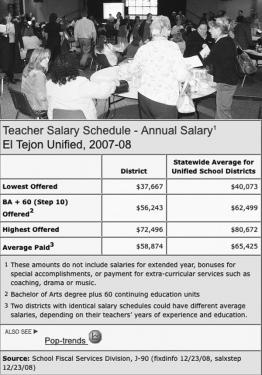
El Tejon Unified School District employees gathered for a rare ?all employees? meeting Monday, Feb. 2 to hear about the impact of the state budget crisis on the schools and their jobs. The chart below shows ETUSD teachers? salaries are already below state averages.
Library, Schools, Jobs, Water System Funds Frozen
By Patric Hedlund
Teachers nervously shared dark humor as they assembled at the Frazier Mountain High School cafetorium, awaiting the start of a rare district-wide “all hands on deck” meeting Monday, Feb. 2 called by El Tejon Unified School District Superintendent Shelly Mason. The agenda was a briefing on how the plunging economy and the skyrocketing state deficit have converged to impact ETUSD’s employees and the mission to educate the mountain’s children. The district has already slashed budgets three years in a row.
Their misery has plenty of company. The Kern County Board of Supervisors officially declared a fiscal emergency Tuesday, Feb. 3 after learning that $34-$75 million may have to be cut from the current fiscal year’s county budget because the state stopped paying money it owes to counties. Tax revenues have also plummeted with waning real estate values.
All Kern County department heads—for libraries, roads, fire, sheriff, animal control, child protective services and more—were ordered to assemble in the supervisors’ chambers to tell how departments could take a machete to mid-year budgets, after cinching their belts as tightly as possible just last June.
Meanwhile, Governor Arnold Schwarzenegger has ordered that most state workers take two days off per month without pay—equal to a 10% salary cut. He also ordered most state offices to close two days a month, including all DMV field offices. The state has halted payments of bond money for public-works projects. Even grant funds from the California Department of Public Health to help Pinon Pines’ Water Company fix their wells and distribution system are frozen.
California’s state bond ratings sank to the lowest of any state in the nation—beneath Louisiana—on Tuesday as well, due to lack of reserves, skyrocketing debt and the failure of California’s legislators to make political progress in budget negotiations.
ETUSD Superintendent Shelly Mason began her meeting for ETUSD employees with a projection screen filled with grim facts:
- In September 2008 the Dow Jones was at 12,000; in December it was at 8,000.
- The California state budget deficit has grown from $6.1 billion in July 2007 to $14.5 billion in January 2008 to $24.3 billion in May to $41.6 billion in December 2008.
One statistic Mason didn’t include is that Kern County’s unemployment rate notched up to 12.5 percent last month. Rumors were flying among teachers that pink slips would be handed out at the Monday meeting. One teacher broke the tension by speculating to her friends, only half in jest, “They’ll make an offer to buy out the senior teachers for $50,000.” That didn’t happen. Mason asked the teachers to help come up with creative solutions to the challenge to cut over half a million dollars over the next 18 months from an already bare-bones budget.
“The governor has proposed a 42% cut in state expenses; 50% of that is in education,” Mason told an estimated 85 district employees. “[Within ETUSD] we expect mid-year cuts of $270 per student, about $312,390, and next year we anticipate this year’s cuts will still be in place plus an additional 2.5 percent reduction per student, about $208,260 for the 2009-10 school year. “How are we going to accomplish this?” she asked. “The good news is that we’ve gotten good at cutting; the bad news is there is no place left to cut.” She pointed to green sheets of paper on the back table. “Give us your good idea in our suggestion box,” she said, motioning to a shoe box on a back table, adding that the facilities manager had suggested pumping septic tanks every two years, instead of annually, to save $10,000.
State sources indicate the word “flexibility” is suggesting that restrictions on special “categorical” funds will be relaxed. Grants for class size reduction and for the arts and physical education, for instance, may be absorbed into the general education fund. That alone may cut five teaching positions. After-school programs will be cut. Fees may be charged for student transportation. Purchase of newly adopted math textbooks is likely to be postponed. A four-day week is being considered.
Funding for in-classroom “Title 1” instructional aides will not be affected, as they are paid with federal money, Mason said. Meanwhile, because of economic hardships, 50.99 percent of students in California now qualify for free and reduced-cost lunches.
“It is living in limbo that is most difficult,” the superintendent said, a phrase echoed repeatedly in the Board of Supervisors’ meeting the next day. County department heads said it is impossible to plan without knowing what funding the state will cut, or what the volume of ‘deferred payments’ by the state will be.
Sheriff Donny Youngblood said a proposed 10 percent cut in his budget could mean loss of 400-500 deputy sheriffs, the closing of outlying substations and release of 1,700 prisoners. Pat Cheadle, Director of the Department of Human Services, said $18 million in cuts to her department would mean laying off 1,100 employees, “leaving only 400 people to service 108,000 claims and over 1,600 referrals about child abuse a month…it would close our doors.”
Diane Duquette, Director of Libraries for Kern County, said it is painful to consider dismantling the system of services and infrastructure that her department has fought to provide to the public, especially when usership has dramatically increased at libraries throughout the county. The system provides affordable education and entertainment services at a time when families are losing jobs and other services are drying up.
Still, library services are on the “third tier,” designated by the board of supervisors as the least-protected from cuts. Public safety departments (such as fire and sheriff) are on the “first tier,” which may be insulated from deep cuts.
At both of these meetings, the federal stimulus plan was mentioned as a possible “point of light.” ETUSD spends $800,000 a year on special education costs that are not reimbursed. Federal funding of that expense alone would solve the district’s problems.
At both meetings, a prediction that economic hardships are likely to continue through 2012 made early use of emergency reserve funds a difficult option to consider.
This is part of the February 06, 2009 online edition of The Mountain Enterprise.
Have an opinion on this matter? We'd like to hear from you.


